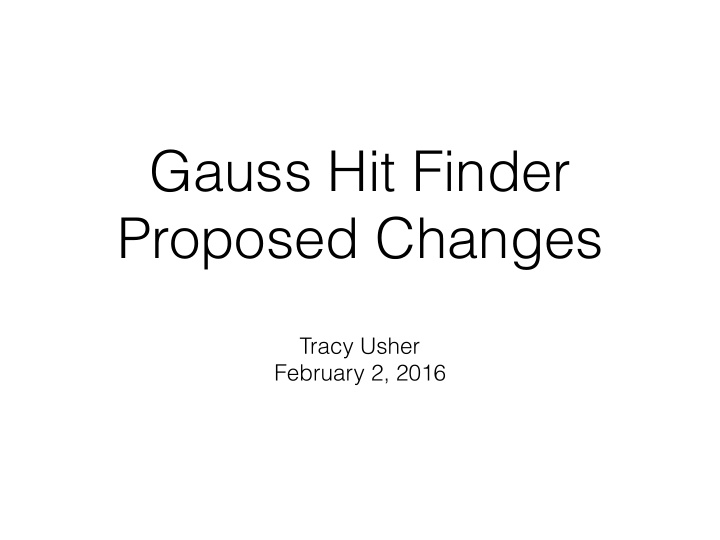



Gauss Hit Finder Proposed Changes Tracy Usher February 2, 2016
Overview Reminder of the strategy for finding/fitting pulses • Proposed modifications to the GausHitFinder_module • A few example waveforms for illustration • Summary • 2
Gaushit Finder - Reminder Hit finder takes as input an “ROI” waveform from the output of the • deconvolution process: Deconvolved Waveform Example from the collection plane The hit finder assumes that pulses to be found will be (positive) • unipolar gaussian shaped pulses It also assumes that multiple pulses that are merged together can • be modeled as individual gaussians This latter assumption is problematic when tracks start to run along • the drift direction or are run parallel to a wire 3
Gaushit Finder - Reminder The hit finder has three main elements: • For a given ROI, search the waveform for maxima points over a • fixed threshold and then the corresponding minima points on either side I’ll call these “snippets” • Loop over these “snippets” to perform the following two tasks: • If two adjacent snippets are overlapping then merge them together • Fit the candidate snippet(s) to a Gaussian shape • Deconvolved Waveform Example from the collection plane Resulting Gaussian Peaks Return parameters describing the fit pulse • Peak time, width, integrated area, etc. • 4
A Few Details… The fit stage actually consists of two parts: • The initial gaussian fit to the candidate peak(s) • If the initial fit chi-square is “poor” then add another peak and refit. • Extra peak is added near the end of the current fit range • this can lead to negative amplitude pulses! • Take the second fit solution if the chi-square is better than first fit • Fit initialization: • Peak positions are constrained to lie within the (merged) snippet • Peak width is initially set to an expected (per plane) value • 5
A Few More Details… Current code limits “merging” of snippets to 2 peaks • Long waveforms consisting of many peaks will be processed in a series of • fits to merged snippets containing 2 peaks at a time - plus refits if poor chi- square Source of observation that area under waveform does not equal sum of fit peak areas • Fits which return a “bad” chi-square, even after adding an extra peak • and re-fitting, will be rejected There is no record of these rejections in the output • Sometimes the fit can fail even for “good” hits… • There is an opportunity to address various output issues • Hit number is on snippet, not on ROI • “sumADC” is sum over entire snippet, not just the returned fit peak • etc. • 6
Proposed Modifications to Hit Finder Restructure • Three main elements of hit finder broken into independent functions • - hopefully easier to maintain/update in future Single function to do gaussian fits to handle both first and second • fits Hopefully less complexity to future developers • Tweaks • Allow multi-peak fits to long pulses • Up to 10 peaks fit simultaneously • Utilizing an existing fhicl parameter which was already set to 10 • Value is arbitrary (?) but observation is that going past ~15 begins to • really impact algorithm time 7
Proposed Modifications to Hit Finder Tweaks (continued) • Waveforms with more than 10 (see above fhicl parameter) candidate • peaks are NOT fit, a single hit will be returned for this pulse Time is center of pulse, width is taken from length of pulse, height from • average of ADC values Similar to cchitfinder • Initializing the fit • Candidate peak positions constrained within peak range, not full snippet • Initial peak widths from width of candidate peak, not fixed value • Limit poor chi-square refits • Still add extra peak near end but ONLY if amplitude will be positive • Chi-square failures now returned as single hit as for long pulses • 8
Proposed Modifications to Hit Finder Goals: • Make module simpler • Primarily for ease of future maintainability • ~920 lines of code down to ~760 • No change to results for single gaussian fits • Improve fits for potentially true multi hit waveforms • Provide alternative output for complex waveforms which probably • don’t have gaussian peak structures Output for all fit attempts • e.g. let user decide to ignore poor chi-square fits • Improve information going into the output hits • 9
Some Comparisons Orignal Hit Finder W plane Updated Hit Finder W plane 10
Some Comparisons Orignal Hit Finder W plane Updated Hit Finder W plane 11
Some Comparisons Orignal Hit Finder V plane This happens on a relatively frequent basis Updated Hit Finder V plane 12
Long Pulses An example of an event W plane which curls for a section to run parallel to the drift drift time direction. wire # Hit Threshold Snippet break here Hit Threshold Hit Threshold 13
Summary Propose an updated version of the GausHitFinder_module • Same strategy and logic of the initial peak finding • Some tweaks and fixes to improve performance in special cases • Better initialization of fits • Allow multi hit fits of longer pulse trains • Recovery for fit failures, mechanism to summarize overly long pulse trains • Essentially the same timing as the original algorithm • Depends on number of gaussians allowed in pulse trains • GausHitFinder_module is shared code - will impact other users • Tingjun has run a trial and sees no adverse impact for dune/lariat • On larreco feature branch: feature/usher_gaushitrestructure • 14
Recommend
More recommend